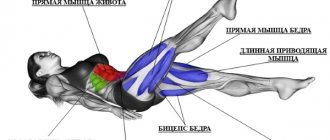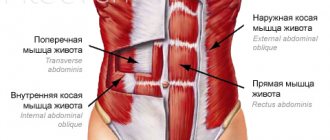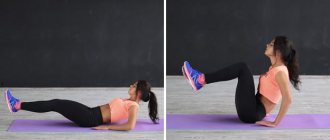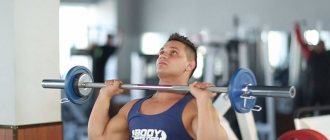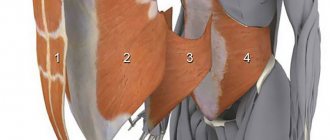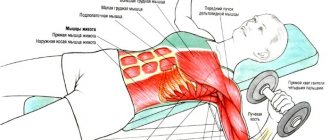Diastasis recti is a separation of the abdominal muscles that occurs in many women after pregnancy. It can be helped by exercises that strengthen the core and transverse abdominal muscles, such as pelvic tilt, Kegel exercises, and abdominal tucks. As well as deep diaphragm breathing and reverse plank or standing plank. Avoid twisting, bending and other similar exercises, they can only worsen the situation.
If you're worried about your belly sticking out after giving birth, trust us, we know how you feel! Diastasis recti, or “mom’s tummy” as it’s also called, occurs in about 40% of unsuspecting new mothers, leaving them looking like they’re still pregnant even six months after giving birth. However, this does not happen after pregnancy.
The internal organs in the abdominal area are held in the abdominal cavity by the abs, or muscles, called the rectus abdominis. These are two muscle formations located vertically on both sides of the peritoneum. During pregnancy, as the belly grows, the linea alba, the tissue connecting the two, stretches and weakens. This weakening is facilitated by the hormones relaxin, progesterone and estrogen produced during pregnancy. This leads to diastasis, or separation of the rectus abdominis muscles.
Separation of the abdominal muscles occurs in all pregnant women, but usually normalizes on its own after childbirth. However, in some cases, the effect lasts for another 4-8 weeks. When the rectus abdominis muscles separate more than two fingers' width (about 25 mm), the belly protrudes so that it appears as if you are still pregnant (as ironic as that may sound!). However, even if you do not take into account the appearance, since the muscles of the peritoneum are responsible for the position of the insides, diastasis can adversely affect posture, core strength, stability and mobility of the back. It can also cause or worsen low back pain, urinary incontinence, umbilical hernia, and pain during intercourse.
The following exercises for diastasis may help you postpartum if your doctor approves of them, especially if you had a C-section. If you suspect you have diastasis during pregnancy and want to take action in advance, consult a physiotherapist: he will check the integrity of the muscle tissue and prescribe a safe prenatal regimen that suits you.
Exercises for diastasis recti
- Abdominal retraction
- Kegel exercise
- Pelvic tilt
- Standing plank with support
- Reverse plank
In the most severe cases, diastasis recti requires surgical correction, but in most situations, abdominal exercises will help you cope with the problem without surgery. What’s good about them is that they will help you both when diastasis is only three months old and when your child is already getting straight A’s from school. In the last few years, exercise programs such as the Tupler technique or the Mutu system have gained popularity. They focus on two aspects - core strengthening and transverse abdominus strengthening. Strong abdominal muscles ensure that the internal muscles have good support and there will be less pressure on other connective tissues. These two aspects are considered more important to overall core strength and stability than the task of completely closing the white line gap.
The following exercises will help you deal with diastasis recti. They are ideal for young as well as older mothers, as they do not take much time and do not require a special regime. Once you master them, you'll be able to exercise right in the middle of a busy day. So how to pump up your abs with diastasis?
Abdominal retraction
Traditional abdominal exercises such as crunches, bicycles, or sit-ups won't work if your abdominal muscles have become loose after childbirth. In fact, many experts state that some of these movements, without specific modifications to suit your task, can be counterproductive and stretch the white line even further.
This basic and deceptively simple movement stabilizes the core and strengthens and tones the transverse muscles. Thus, abdominal retraction is the basis for any exercise designed to treat diastasis of the rectus abdominis muscles without surgery.
- Lie on your back with your knees bent. Breathe normally.
- Pull your stomach in below the navel, try to make the peritoneum “stick” to the spine.
- Don't hold your breath or suck in your entire stomach like you're posing for a photo! The movement should only engage the lower abdomen.
- Hold the pose for 10-30 seconds.
- Try to do 10 repetitions 3 times a day.
Once you master the exercise, you can do it sitting, standing, or even holding your baby.
Kegel exercise
Kegel exercises can relieve you of a host of problems, ranging from urinary incontinence to the inability to have an orgasm. This simple movement involves contracting the pelvic floor muscles and can also help strengthen the peritoneum.
- Lie down in a position that is comfortable for you.
- Breathe normally and contract the muscles at the front and back of your pelvic floor as if you were trying to stop urinating.
- Hold the tension for 10 seconds.
- Perform 20 repetitions three times a day.
To wear or not to wear a belt?
The use of a special belt for diastasis recti, especially for exercises, is an integral part of some training programs. While there's no evidence that the belt can strengthen your abs or eliminate linea alba strain, it can definitely help support your lower back and make your tummy bulge less noticeable. If you decide to use a belt, your physical therapist will show you how to use it and adjust it to suit you.
Strengthening and restoring the core after pregnancy is a multifaceted process that does not end with solving the problem of rectus abdominis muscle separation. In addition, you need to pay attention to correct posture, sufficient rest, and avoid heavy loads. Once you have mastered the movements to correct diastasis, make them part of your daily routine and you will certainly see results!
For many women, the birth of a child and pregnancy are associated not only with the euphoria of motherhood, but also with a saggy and enlarged belly. For some women in labor, the abdominal muscles return to normal without much effort, and for some, even numerous sports trainings become unsuccessful.
If a woman does not see the result of her efforts, it is necessary to find out the reason for the lack of a positive effect. At home, you can carry out self-diagnosis to exclude one of the most common complications - diastasis of the rectus abdominis muscles, due to the peculiarities of the restructuring of the body during pregnancy.
What is diastasis
Diastasis of the rectus abdominis muscles is a divergence of the muscles so that a gap of at least 27 mm and at least 22 mm at a height of 30 mm from the navel appears between their inner edges in the navel area. The appearance of a lumen is associated with a weakening and thinning of the membrane, due to which it cannot hold the muscles as before. Diastasis is observed in the following groups of people:
- pregnant women;
- newborns (due to poor development of the anterior peritoneal wall, usually in those born prematurely);
- in adults (extremely rare and usually occurs due to degenerative tissue changes).
Did you know? Diastasis is quite common in 3% of men with HIV.
The development of diastasis in pregnant women is associated with increasing pressure on the abdominal muscles, especially in the last stages. Sometimes the reasons may be heredity, weak abs or excessive physical activity. In different countries, different doctors classify membrane weakening in different ways, but the most common option is this:
- the distance between the muscles is 50–70 mm in the umbilical zone (observed after childbirth, the appearance of the abdomen practically does not change);
- distance 70–100 mm (the lateral muscles also relax, the silhouette of the abdomen changes, it sags);
- distance greater than 100 mm (weakened abdominal muscles, prolapse of the peritoneal organs, hernias appear).
The latter type usually requires surgery.
What is it and why does it appear?
As a rule, diastasis occurs in pregnant women as a result of increased stress on the abdominal muscles during pregnancy. In rare cases, it may be caused by a genetic predisposition, weak abdominal muscles, or heavy physical activity.
The degree of development of diastasis is determined by the width of the muscle divergence:
- 1st degree – discrepancy 2-5 cm;
- 2nd degree – discrepancy 5-7 cm;
- Grade 3 – discrepancy more than 7 cm.
Based on the location of the discrepancy, it is divided into 3 types:
- above the navel;
- under the navel;
- mixed type (both above and below the navel).
Photo and schematic representation of the divergence of the abdominal muscles after childbirth:
How to diagnose diastasis
In order to independently diagnose diastasis, you need to perform the following steps:
- lie down on a hard surface;
- bend your knees;
- place your feet on the floor and move them as close to your buttocks as possible;
- place your fingertips above and below the navel (about 3-5 cm) on the midline of the torso;
- Keeping your abdominal muscles relaxed, lift your head and shoulders off the floor.
If you were able to feel a depression under or above your navel, then you have diastasis. The deeper this depression, the more severe your disease.
Indirectly, divergence of the rectus abdominis muscles is indicated by back pain, an excessively wide waist, a change in the shape of the navel, as well as the presence of a large belly that does not decrease or continues to grow, despite proper nutrition and exercise.
What not to do with diastasis
Once diastasis recti is detected, activities that increase intra-abdominal pressure should be avoided. Such activities include lifting heavy objects, loudly laughing or coughing, sleeping on your stomach, slouching, and performing classic abdominal exercises. Workouts that lead to belly growth:
- lifting the body from a lying position;
- push-ups, planks and any exercises that focus on the hands or elbows;
- lifting legs straight or bent at the knees from a lying or hanging position, including “bicycle” and “scissors”;
- power crunches;
- yoga practices that place strong pressure on the midline of the abdomen;
- weighted squats and lunges;
- strong backbends, side bends, pull-ups;
- strength exercises using various weights;
- jumping.
They need to be excluded from your training.
Prohibitions
After confirming this diagnosis, you should not do activities that increase intra-abdominal pressure. For example, lifting weights, laughing a lot, slouching, using the classic method to pump up your abs, you need to sleep either on your back or on your side.
Read also: What to do if your breasts sag after childbirth (Video)
Practices that are better NOT to do:
- lifting the upper body from a lying position;
- training with emphasis on arms or elbows (push-ups, planks);
- lifting legs from a lying position (for example, “bicycle” or “scissors”);
- yoga, in which the midline of the abdominal region is strongly pressed;
- squats;
- deep bends back, bends to the side;
- strength exercises with weights;
- jumping.
All of the listed types must be crossed off the list during training.
Precautions for postpartum diastasis
When the abdominal muscles diverge after childbirth, it is necessary to pay attention not only to the exercises performed, but also to everyday physical activity.
- When coughing, laughing, or sneezing too much, support your abs with your hands and apply gentle pressure to avoid putting unnecessary pressure on your abdominal muscles.
- Do not lift heavy things over 5-6 kg.
- Lift things weighing less than 5 kg with your arms bent at the elbows (not straight!). When picking things up from the floor, squat rather than bend.
- When rocking your baby, wear a postpartum bandage or tighten the tummy with an elastic bandage.
- Sleep on your side/back (not your chest!).
- Before getting out of bed or lying on it, roll over onto your side. And get up from the “lying on your side” position.
- Before getting up from the chair, you need to shift your weight to your left or right buttock and pull in your stomach. Stand up primarily using your legs, without straining your abs. You can push off with your hands.
Precautionary measures
If labor diastasis is observed, you should be extremely attentive to various little things:
- When coughing, sneezing, laughing, hold your abdominal muscles with your hands using light pressure.
- Lift weights not exceeding 5000–6000 g.
- Lift a load of permissible weight with bent arms. If you need to lift a weight from the ground, squat down, but do not bend over.
- Put on a bandage or wrap an elastic bandage around your stomach and only then start rocking your newborn.
- You can sleep in any position except on your stomach.
- Always leave bed after turning onto your side.
- When rising from a chair, shift your weight to one of your buttocks and tighten your stomach. When lifting, you need to use your leg muscles, not your abs.
Exercises that are not advisable to perform when the membrane is weakened:
- raising the upper body from a lying position;
- push-ups, planks and any other exercises that require emphasis on the upper limbs;
- raise straight or bent lower limbs while lying down or hanging;
- "bicycle", "scissors";
- perform crunches;
- squat and lunge with a load;
- pull-ups, bending back, bending to the sides;
- jumping;
- power load with weights.
Did you know? Weakening of the membrane
in pregnant women during the last term occurs in 66–100
%
of cases.
Physical exercise
Now let's look at what needs to be done if the abdominal muscles become loose after childbirth. Keep in mind that when performing exercises for diastasis after childbirth, special attention should be paid to breathing. Do not inflate your stomach too much with each breath. And if you are diagnosed with diastasis of 2 or 3 degrees, then you should do the exercises in a bandage.
Exercises for diastasis of the rectus abdominis muscles.
Exercise "Cat"
- Get on all fours (keep your back straight).
- Place your hands shoulder-width apart.
- As you exhale, pull in your stomach and arch your back like a cat.
- Then, as you inhale, bend your back slightly, keeping your tummy pulled in.
- Perform 10-15 repetitions.
Physical exercise
Now let’s look at what exercises will help against diastasis. When doing gymnastics, do not forget about proper breathing (when inhaling, do not inflate your belly too much). If you have confirmed stage 2 or 3, then do exercises in a bandage.
Exercises for diastasis after childbirth for the rectus muscles.
"Cat"
Take a pose on all fours (your back should be straight). Hands shoulder width apart. When you exhale, pull your stomach in and arch your back like a cat. Then, as you inhale, bend your back slightly, keeping your stomach pulled in. Repeat 10 to 15 times.
Read also Tattoos on the stomach of girls after childbirth: photos, when to do it
This is a very effective practice. It is also used to prevent back problems.
Retraction
Pull in as if you want to touch the vertebra with your navel. Then relax and retract, and so on in turn. Number of times: 5 sets of 100. Breathe evenly while performing. This practice is very convenient, because you can do it in any position (sitting, lying, standing).
Kegel technique
Tighten your groin muscles while counting to ten. Then slowly relax them. We do 5 repetitions, gradually increasing to 25. This affects the strengthening of the pelvic floor. If you combine this procedure with breathing, you can achieve visible positive results.
Compressions using the Julia Tupler method
Lying down, bend your knees, feet on the floor. Place a towel under the lumbar area, crossing the ends at your waist, and hold them with your hands. As you exhale, raise your shoulders and head, without letting go of the towel. This technique helps tighten the abdominal wall. When performed daily, the effect is visible after a couple of weeks.
"Shoulder bridge"
Starting position: lying on your back, legs bent, feet at a level slightly wider than your hips. The arms lie along the body, palms down. As you exhale, raise your pelvis, then as you inhale, lower it. Repeat 10-15 times.
"A hundred"
Lie on your back, bend your legs, place your feet on the floor, arms parallel to your body, palms down.
As you exhale, raise your head and shoulders a little. Tuck your chin to your chest and suck in your stomach. We pause for a couple of seconds. As you exhale, we return to the starting position. So we continue for 10-15 approaches. Important: we do not lift the entire body of the body (as in the classic abdominal swing), but only the head and a little bit of the shoulders.
Leg Curl
The starting position is the same as before. Bend and straighten your legs, sliding your feet along the surface. The number of times for each leg is up to 15.
Read also: Quick weight loss program at home after childbirth
For the lower back
The starting position is the same. First, pull in your abdominal area, lower your head to one side, and at the same time your knees to the other. Maintain this position for a couple of seconds. Next we continue according to the same principle. The number of executions is 10-15 times.
Pulls
Standing on all fours, hands shoulder-width apart, extend your right arm and left leg forward and upward. Stay like this for a little while. Next, start the starting position again, and repeat everything with the other arm and leg (up to 15 times for each side).
Attention! We perform all exercises with the abdominal cavity retracted.

